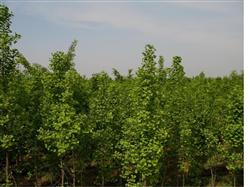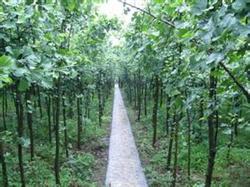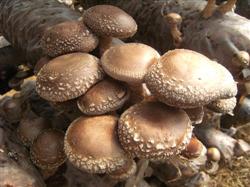Fertilization skills of Ginkgo biloba

First, autumn hole application of organic fertilizer and compound fertilizer, hole application is around the crown or in the tree plate, digging 40-60 cm deep, 50 cm diameter fertilizer hole. Generally, there are 1-2 holes per tree during the period of young trees, 2-4 holes per tree in the first fruit, and 4-6 holes per tree in the full fruit period. Fill the bottom of the hole with 20cm thick rotten crude organic matter (such as crop straw, fine broken branches, etc.), then mix fertilizer and topsoil according to the proportion of 1:3 and then fill it into the hole (100g compound fertilizer for each hole), fill it up and pour water into it. After the water seeps, sprinkle the bottom soil into the ground surface and flatten the tree plate. The direction of fertilization is staggered every year, and the amount of fertilizer application is increasing year by year. The application of organic fertilizer and compound fertilizer in autumn can effectively improve the soil of the application hole, make the soil fertile, have good physical and chemical properties, and create a nutritious environment for root growth, although the range of fertilization is small, but the fertilizer is concentrated. Second, timely topdressing underground during the growing period. The method of fertilization is to open a ditch with a depth of 5-10 cm between rows, apply fertilizer into the ditch, and water it immediately after fertilization. ⑴ Leaf picking Garden. There are three times of underground topdressing in a year: the first application of urea 20-25 kg per mu about 10 days before germination, the second application of 25 kg urea per mu before the peak of shoot growth (mid-May), and the third application of multi-component compound fertilizer 20-25 kg per mu in early August. ⑵ result Park. Because the tree age is big and small, the fruit is more and less, the tree potential is strong and weak, the storage nutrition level of the tree is high and low, and so on, so the tree should be fertilized according to local conditions. Young trees (before fruiting) applied topdressing twice a year: the first time in the first and middle of May, 10-15 kg urea per mu, and the second 15 kg per mu of multi-component compound fertilizer from late August to early September. The results were topdressing 4 times a year: urea 25 kg per mu about 10 days before germination, 15-20 kg urea and 15 kg potassium dihydrogen phosphate per mu about 7 days before shoot growth peak in the second time, 20 kg per mu from late July to early August, and 15 kg per mu in the first and middle of September. Third, assist foliar fertilization. According to the growth and development characteristics of Ginkgo biloba, foliar fertilizer spraying can be carried out six times a year; for the first time, spraying 3-5% urea solution once about 20 days before germination in early spring can effectively solve the problems of low soil temperature, late root activity and poor absorptive capacity in early spring; spraying 0.2% urea solution the second time about 15 days after germination can promote the growth of young leaves and increase the photosynthesis of leaves. The third time in mid-May, spraying 0.5% urea solution can mainly accelerate the growth of new shoots and increase the growth of branches in the same year; the fourth time in mid-June, spray 0.5% urea solution to promote new shoot growth and flower bud formation; the fifth time in early July, spraying 0.3% potassium dihydrogen phosphate solution can prolong the new shoot growth period and promote flower bud formation. The sixth time in late August, 0.4% potassium dihydrogen phosphate solution was sprayed, mainly to improve the photosynthetic function of leaves and the fresh weight of single leaf, and promote the growth and development of fruit.
- Prev

Three-dimensional cultivation of Ginkgo biloba auricula
It is necessary to master the essentials of planting ginkgo biloba, that is, "strong, big, sufficient, dry, solid, shallow, transparent and high". In order to facilitate memory, the song formula is: "Miaozhuang acupoint big base fat; dry soil to fill holes layer by layer; seedlings to shallow water to penetrate; high soil to prevent lodging. Air circulation, high ground temperature, eight characters should be easy to master, according to this."
- Next

Tobacco stems can be planted with Lentinus edodes
Using tobacco stem as bag culture material to grow Lentinus edodes, it has the advantages of high yield, good quality and early emergence. The structure of tobacco stem is loose, the vascular bundle is well developed, it is easy to crush, and the culture material has good ventilation. The specific formula is 22.5% of tobacco stem, 1% of gypsum, 52% of sawdust, 23% of wheat bran, 1% of brown sugar, 50% of moisture content of nutrients and 60% of other tubes.
Related
- Fuxing push coffee new agricultural production and marketing class: lack of small-scale processing plants
- Jujube rice field leisure farm deep ploughing Yilan for five years to create a space for organic food and play
- Nongyu Farm-A trial of organic papaya for brave women with advanced technology
- Four points for attention in the prevention and control of diseases and insect pests of edible fungi
- How to add nutrient solution to Edible Fungi
- Is there any good way to control edible fungus mites?
- Open Inoculation Technology of Edible Fungi
- Is there any clever way to use fertilizer for edible fungus in winter?
- What agents are used to kill the pathogens of edible fungi in the mushroom shed?
- Rapid drying of Edible Fungi

